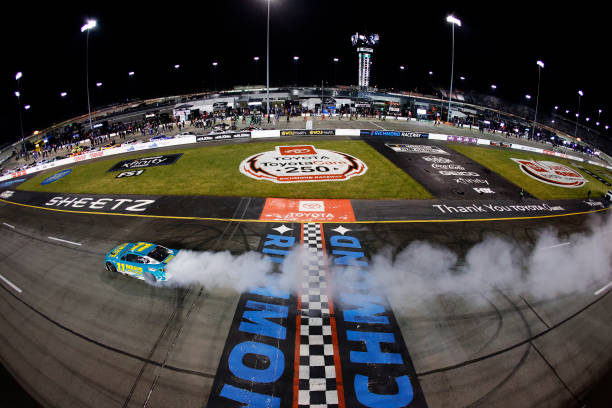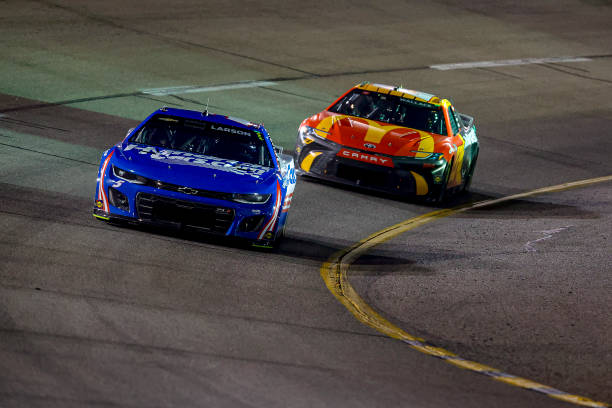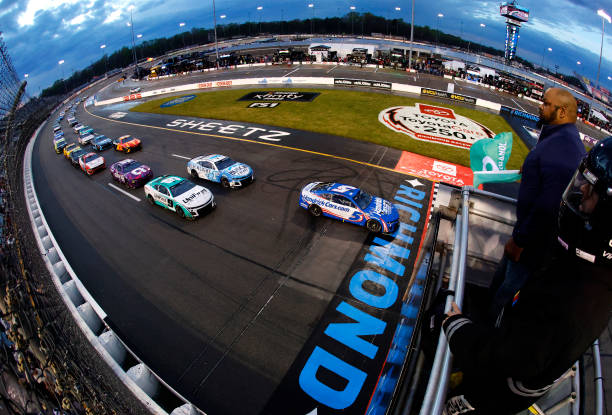Well, it was only a matter of time. NASCAR has been doing a solid job in keeping their officiating out of the post-weekend headlines. Outside of the finish to the Daytona 500, there has been little to complain about from NASCAR. Sure, there were quibbles about whether the track limit penalties at COTA were excessive. However, the Toyota Owners 400 made up for lost time. The spring Richmond race had a lot to discuss, outside the actual on-track action. After a long history of being a shining example of quality racing, Richmond Raceway has drastically lost its luster. Hopefully, the weekend’s activities did not dull your Easter holiday. Now on April Fools Day, it is time for Overreaction Monday for the spring Richmond weekend.
NASCAR’s Inconsistent Officiating Strikes

As mentioned in the introduction, the officiating this season in NASCAR has been fairly noncontroversial. The late caution thrown at the end of the Daytona 500 is the only moment that truly stands out. Even with that, the potential issues that fans had with it did not come down to whether NASCAR was right or wrong. Rather, it was a question of consistency. When it comes to judgement calls in NASCAR, their track record is not the most forgiving. During one week, NASCAR will call cautions quickly, the rules by the book, and hit teams with harsh penalties. Then, the officials will follow it up with a week of waiting out incidents before throwing a yellow and leaving gray area in the rules.
Sunday demonstrated NASCAR’s inconsistency throughout the race. While NASCAR should be commended for getting the race started under damp conditions, it was followed up with excessive yellow flag laps and taking tire decisions out of the teams’ hands. That was only the beginning of the fun though. During Stage 2, there were a handful of drivers who were attempting to split the stage in half. While the majority of the field was on the two-stop strategy, Kyle Larson, Bubba Wallace, and Alex Bowman (among others) were on the one stopper. After those drivers did their stop, the main intrigue of the stage was to the see how the different strategies played out.
But that never got to unfold. Instead, Kyle Busch lightly kissed the Turn 2 wall and triggered a yellow. This upended the one-stoppers race, especially Alex Bowman who got trapped a lap down. Why was the yellow thrown? Busch ran up the race track, got into the wall, and then powered forward without incident. After a myriad of wall scrappers and slow cars at Bristol went without caution, it was jarring to see NASCAR with the trigger finger. Plus, it ruined any differing strategies from playing out in the final stage.
What is Restart Zone?
After a late caution with 2 to go rained on Martin Truex Jr’s day, Denny Hamlin emerged from the pit stops with the lead. Knowing that Truex had the better car, Hamlin had to time the restart perfectly. As they approached the GEICO Restart Zone, Hamlin accelerated before hitting the white line. FOX’s booth commented on it immediately, and replays only confirmed their suspicions (even if they did not confirm it themselves). Denny Hamlin jumped the restart, pretty blatantly to be fair.
With that clear rules violation, NASCAR definitely stepped in and penalized Hamlin for his rule violation. At the very least, NASCAR was transparent about their review process and explained how Hamlin did not jump the restart zone. Right? Of course not, this is NASCAR.
Similar to the ending of the Daytona 500, there is legitimate reason to understand why NASCAR is not penalizing Hamlin. If they scrutinized every restart (especially on a green-white-checkered), then they would be hard pressed to find clean restarts. However, it is disgruntling to watch NASCAR use a special camera for the esses at COTA to penalize drivers for violating track limits by mere issues. The benefit from that “rules violation” was minimal compared to the penalty. Meanwhile, Hamlin jumping the restart likely led to him winning the race. For that violation, NASCAR claims nothing happened.
The Fix Is In
NASCAR officiating cannot be this inconsistent or poorly done. So there must be an ulterior motive. Denny Hamlin is from the Richmond area. Richmond Raceway is Hamlin’s home track. The FOX booth cannot shut up about Hamlin being the “hometown” driver. Clearly, NASCAR rigged the race so Hamlin could win. At the very least, they turned a blind eye to clear race manipulation by Hamlin’s employed driver: Bubba Wallace. Wallace could have lifted to avoid Kyle Larson, but he had orders to get a caution no matter what. NASCAR knew too. However, it extends further than this. Through 7 races, all but one have been won by a driver heavily featured on NASCAR’s Netflix show. Rigged!

While “obviously” might be too strong of a word, it is highly unlikely that any sort of fix or rigging system is in place. Sure, one could argue about a call here or there. Add in the blind eye to Hamlin’s jumped restart and that helps cook up some conspiracy theories. However, the Toyota Owners 400 would not be the race to use to be proof of rigging the system. Wallace spinning Larson did not look devious, especially considering it benefitted Larson and hurt Wallace in the end. The lack of penalty on Hamlin post-race fits with NASCAR’s decision making. Remember Kevin Harvick’s Talladega penalty last year? Now, ask yourself if you really believe they make the same call if Harvick won the race.
As for the Netflix coincidence, the drivers to have won from the show are Kyle Larson, William Byron, Denny Hamlin, and Christopher Bell. All four are top contenders driving for the two best race teams in the Cup Series. Is it really a surprise that the Netflix show drivers are winning? It did focus on playoff drivers.
Turn the Sprinklers On

Until they fix Richmond Raceway (or the NextGen on short tracks), NASCAR could dampen the track prior to the summer race. Borrow the watering trucks from the local dirt tracks and get the track moist for the Cup Series race. The best racing at Richmond (for the Cup Series) took place during the first 30 laps of the event. When the wet tires were on, the action on track was a joy to watch. Drivers were able to knife their way through the field while others dropped down the leaderboard. Passing was on display due to multiple lines being viable. It sort of resembled how Richmond used to be. Then NASCAR dictated to teams to put the slicks back on.
Richmond Raceway has been the ire for so many fans. Even before the NextGen car, Richmond has been a disappointment. The lone saving grace to some form of enjoyment is the tire strategy. However, that was deprived from fans on Sunday due to the Busch caution in Stage 2. In the final stage, no team really wanted to take the chance to use a different strategy. Christopher Bell and Denny Hamlin took a mild chance by waiting an extra 10 laps to pit, but that was hardly compelling TV. So even the strategy element was gone for this past weekend.
While it is unrealistic for NASCAR to artificially wet the track for a Richmond race, it does sound like the short track is on the verge of losing a race. It makes sense, yet it is sad to see it happen (if it does). Between the NextGen car and the track itself, the entertainment value of Richmond Raceway is minimal for the Cup Series. Maybe NASCAR can get lucky with light rain during Richmond weekends.


